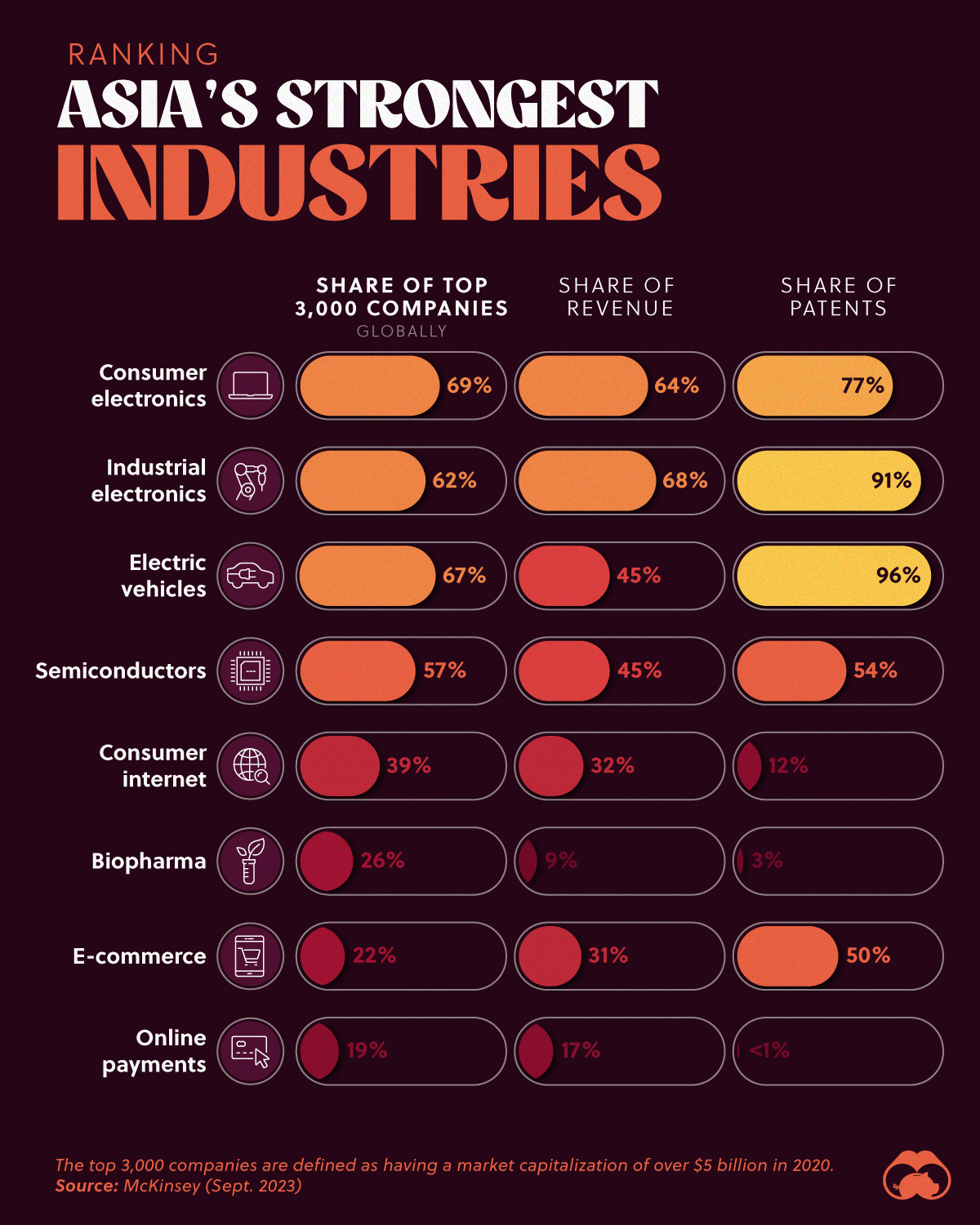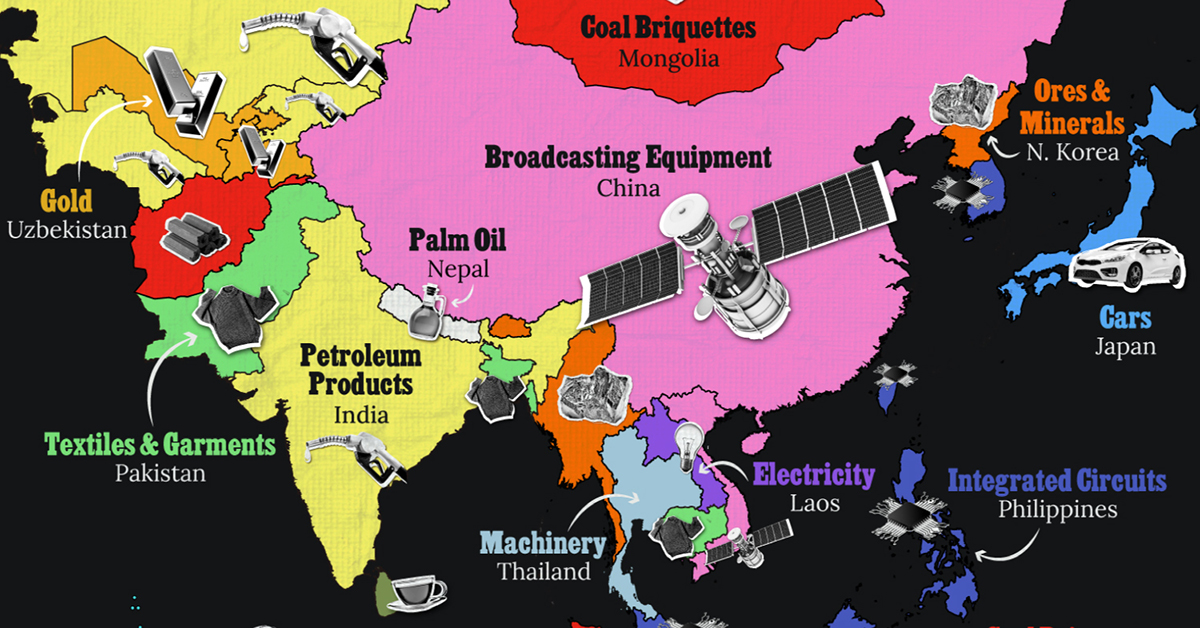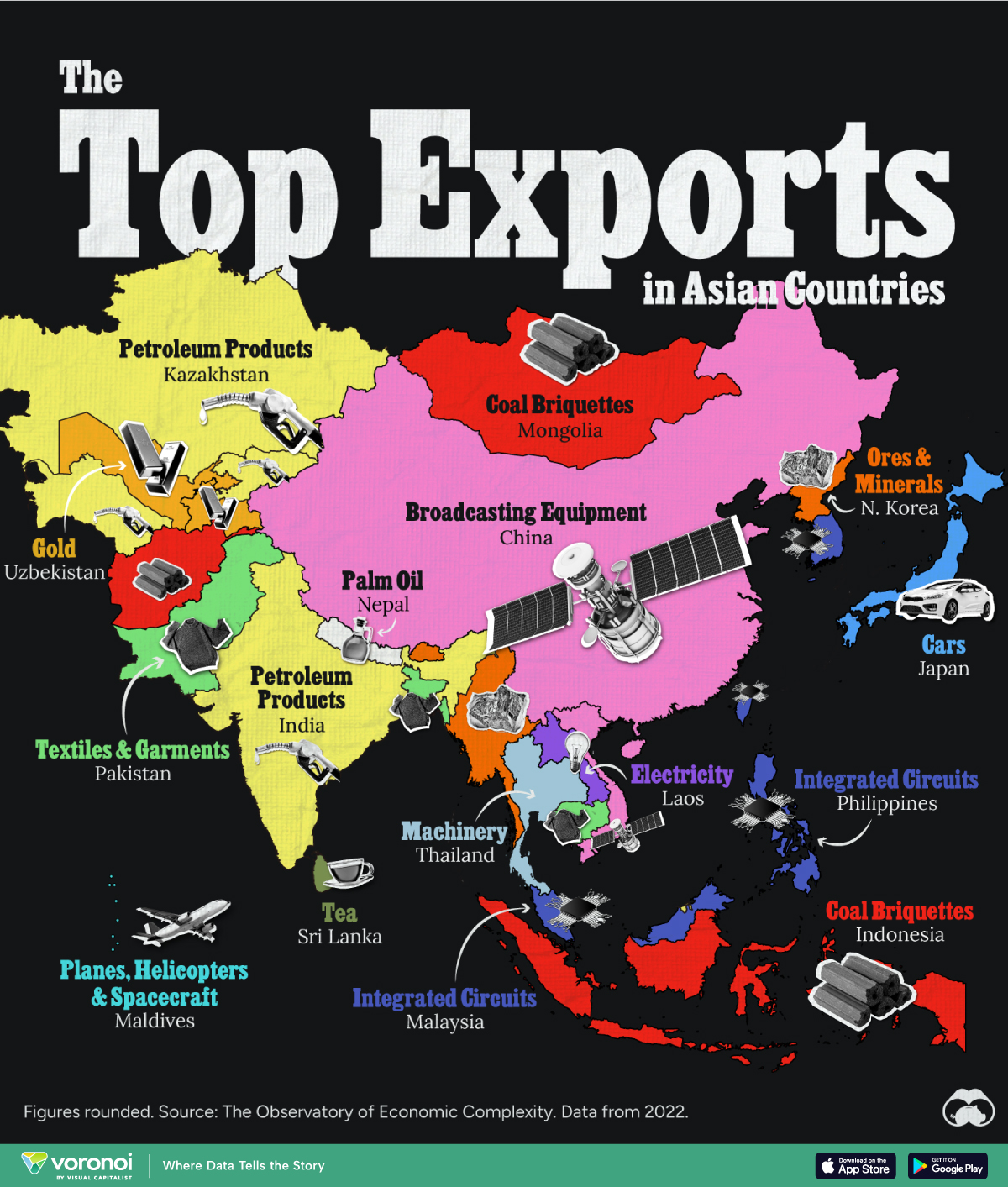Globalization
Charted: The Industries Where Asian Companies are the Strongest

The Industries Where Asian Companies are the Strongest
The last 30 years of globalization have benefited Asia greatly.
As a result of deepening trade relations and access to other markets, Asian companies have grown in output and prominence. But which sectors do they excel in?
Using data from McKinsey Global Institute we visualize Asian companies’ share of the top 3,000 global companies, broken down by industry, revenue, and patent share.
A top 3,000 company was defined as having a market capitalization of over $5 billion in 2020.
Ranking Asia’s Strongest Industries
Unsurprisingly, among the top 3,000 companies globally, Asian companies are most prevalent in the manufacturing sector. Specifically, the region’s strength is in industries like consumer electronics, industrial electronics, electric vehicles, and semiconductors.
For many Asian countries, manufacturing is the bulwark of the economy. In Asia’s largest economy, China, the manufacturing sector accounts for nearly one-third of economic output. In Asia’s 13th largest economy, Vietnam, it accounts for almost one-fourth of gross domestic product.
However, manufacturing isn’t all what Asia is known for anymore. Here’s a full list of the top Asian companies’ share in various industries.
| Industry | Asian Share of Top 3,000 Companies | Revenue Share (%) | Patent Share (%) |
|---|---|---|---|
| Consumer electronics | 69% | 64% | 77% |
| Industrial electronics | 62% | 68% | 91% |
| Electric vehicles | 67% | 45% | 96% |
| Semiconductors | 57% | 45% | 54% |
| Consumer internet | 39% | 32% | 12% |
| Biopharma | 26% | 9% | 3% |
| E-commerce | 22% | 31% | 50% |
| Online payments | 19% | 17% | <1% |
Note: The top 3,000 companies list is industry agnostic; companies are classified by sector according to their main business.
Another fast-growing industry where Asian companies are thriving is in the consumer internet services space. Asia is home to half of the world’s internet users, which is driving innovation within the region’s online services industry.
And even though Asia is home to “only” 22% of e-commerce companies within the top 3,000, these firms accounted for 50% of patents granted.
Five Distinct “Asias”
Asia is of course a vast place, and for this reason McKinsey divides the Asia-Pacific region into five distinct “Asias” to get a more granular view. For the most part, they use UN country groupings here, though McKinsey notes it excludes parts of Western Asia (i.e. the Middle East) due to dissimilarities with other Asia-Pacific economies:
- Advanced Asia: High per-capita GDP, urbanization, and connectivity. Includes Australia, New Zealand, Japan, South Korea, and Singapore.
- China: 18% of global GDP and population.
- Emerging Asia: Southeast Asia, strong regional connections and trade. Includes Indonesia, Vietnam, Thailand, and others.
- India: 18% of global population but only 3% of global GDP.
- Frontier Asia: Limited integration, large populations and potential. Includes Pakistan, Bangladesh, Sri Lanka, and others.
McKinsey noted that the region is economically integrated—without formal political governance and despite sometimes being at odds with each territorially—with 59% of Asian trade done with other Asian countries.
Maps
Mapped: The Top Exports in Asian Countries
Asia’s exports span a wide range, from petroleum to technology components and textile products.

The Top Exports in Asian Countries
This was originally posted on our Voronoi app. Download the app for free on iOS or Android and discover incredible data-driven charts from a variety of trusted sources.
Asia’s exports span a wide range, from petroleum and minerals to technology components and textile products.
In this map, we display the top exports (as of 2022) of Asian countries, excluding Middle Eastern nations. Data was sourced from The Observatory of Economic Complexity.
Editor’s Note: For our most recent Middle East themed version of this map, go here.
Diverse Economies Across the Continent
Like in many other countries around the world, petroleum is a significant component of the Asian continental economy, with petroleum products as India’s top exporting category, amounting to approximately $86 billion per year in trade.
Another top product coming from Asia is integrated circuits. These are used in a multitude of applications spanning computing, communications, consumer electronics, automotive, industrial automation, medical devices, aerospace and defense.
| Country | Top Export (2022) | Top Export Value (USD Billions) |
|---|---|---|
| 🇨🇳 China | Broadcasting Equipment | $272.0 |
| 🇹🇼 Taiwan | Integrated Circuits | $223.0 |
| 🇰🇷 South Korea | Integrated Circuits | $121.0 |
| 🇯🇵 Japan | Cars | $89.0 |
| 🇮🇳 India | Petroleum Products | $86.2 |
| 🇸🇬 Singapore | Integrated Circuits | $81.9 |
| 🇲🇾 Malaysia | Integrated Circuits | $78.9 |
| 🇻🇳 Vietnam | Broadcasting Equipment | $58.5 |
| 🇮🇩 Indonesia | Coal Briquettes | $50.8 |
| 🇰🇿 Kazakhstan | Petroleum Products | $47.6 |
| 🇵🇭 Philippines | Integrated Circuits | $32.4 |
| 🇦🇿 Azerbaijan | Petroleum Products | $19.4 |
| 🇹🇭 Thailand | Machinery | $19.3 |
| 🇹🇲 Turkmenistan | Petroleum Products | $9.2 |
| 🇧🇩 Bangladesh | Textiles and Garments | $9.1 |
| 🇲🇳 Mongolia | Coal Briquettes | $6.5 |
| 🇺🇿 Uzbekistan | Gold | $5.2 |
| 🇧🇳 Brunei | Petroleum Products | $4.9 |
| 🇵🇰 Pakistan | Textiles and Garments | $4.9 |
| 🇲🇲 Myanmar (Burma) | Ore & Minerals | $4.1 |
| 🇰🇭 Cambodia | Textiles and Garments | $3.1 |
| 🇱🇦 Laos | Electricity | $2.4 |
| 🇱🇰 Sri Lanka | Tea | $1.3 |
| 🇬🇪 Georgia | Ore & Minerals | $1.0 |
| 🇦🇲 Armenia | Ore & Minerals | $0.7 |
| 🇹🇯 Tajikistan | Gold | $0.6 |
| 🇦🇫 Afghanistan | Coal Briquettes | $0.4 |
| 🇲🇻 Maldives | Planes, Helicopters, Spacecraft | $0.4 |
| 🇧🇹 Bhutan | Ore & Minerals | $0.3 |
| 🇹🇱 Timor-Leste (East Timor) | Petroleum Products | $0.3 |
| 🇳🇵 Nepal | Palm Oil | $0.2 |
| 🇰🇬 Kyrgyzstan | Petroleum Products | $0.1 |
| 🇰🇵 North Korea | Ore & Minerals | $0.03 |
In addition, the region is also a big manufacturer of semiconductors, crucial for applications ranging from telecommunications and artificial intelligence to renewable energy and healthcare. Taiwan holds a 68% share of the advanced semiconductor market.
Pakistan, Bangladesh, and Cambodia are major producers of textile products such as t-shirts, sweaters, and household linens. Most of their products go to the United States and Europe, feeding popular outfit brands.
Asia stands out as a top producer of minerals and fuel, with Afghanistan, Indonesia, and Mongolia being top producers of coal briquettes used for heating, cooking, and industrial processes, while Armenia, Georgia, Bhutan, Myanmar (Burma), and North Korea rely on ore and mineral extraction as their top exporting sector.
The largest Asian economy, China, is known for the production of a variety of products, but its top exports come from broadcasting equipment, including TVs, cameras, and radios.
-

 Personal Finance1 week ago
Personal Finance1 week agoVisualizing the Tax Burden of Every U.S. State
-

 Misc6 days ago
Misc6 days agoVisualized: Aircraft Carriers by Country
-

 Culture7 days ago
Culture7 days agoHow Popular Snack Brand Logos Have Changed
-

 Mining1 week ago
Mining1 week agoVisualizing Copper Production by Country in 2023
-

 Politics1 week ago
Politics1 week agoCharted: How Americans Feel About Federal Government Agencies
-

 Healthcare1 week ago
Healthcare1 week agoWhich Countries Have the Highest Infant Mortality Rates?
-

 Demographics1 week ago
Demographics1 week agoMapped: U.S. Immigrants by Region
-

 Economy1 week ago
Economy1 week agoMapped: Southeast Asia’s GDP Per Capita, by Country












